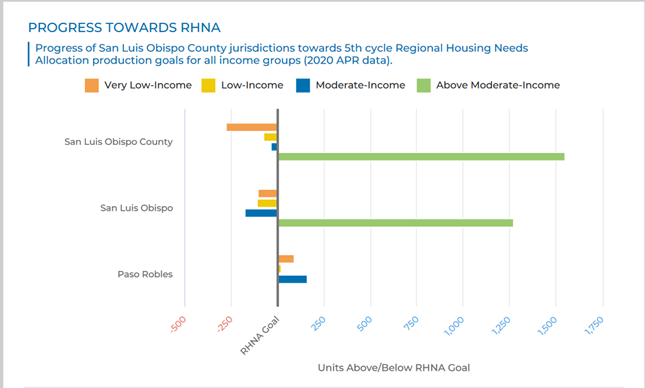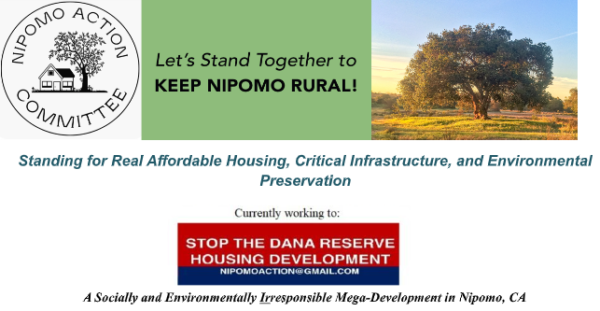Affordable Housing:
The Dana Reserve (DR) mega-development claims the following on its FB page: “Did you know that the Regional Housing Needs Assessment (RHNA) has identified the need for 3,256 new homes in the unincorporated area of SLO County. With the Dana Reserve development project, we aim to do our part to ease the housing crisis on the #CentralCoast by building homes for the missing middle.”
BUT, they are not addressing the real need as identified by the RHNA which clearly states according to this graph that the county has ALREADY surpassed its goal for “above moderate-income” homes constructed, by over 1500 houses.

In the most dense urban development yet in Nipomo, the Dana Reserve says they are donating a lot to Peoples Self-Help Housing who plans on building 104 units right next to 101 following the traditional model of positioning lower income families in high traffic, noise and polluted sections of lands. The balance of the Dana Reserve homes will cost between $600K-$1.2 million, for which there is NO NEED in SLO County.
Nipomo Is Residential
• Based on the analysis provided above, the project would result in the addition of approximately 4,555 new residents and would generate approximately 273 new jobs within the unincorporated community of Nipomo. (DEIR 4.14-24)
• Based on information provided in the South County Area Plan and the 2019 Regional Housing Needs Allocation Plan (see Table 4.14-10; SLOCOG 2019a), the community of Nipomo is a housing-rich community, with a majority of workers commuting to other localities for work. (DEIR 4.14-24)
• Population growth is considered significant only if it is substantial and/or unplanned. In order to reach a buildout population of 23,462 by the year 2060, the community of Nipomo would need to gain an average of 1,321.5 people every 10 years, which would result in a population of approximately 19,498 by the year 2030. The project is anticipated to result in construction of 831 single-family residences, 458 multi-family dwelling units, and approximately 11 ADUs (assuming average of 1.52 ADUs constructed per year) between 2024 and 2029, resulting in a total population growth of approximately 4,108 residents. This would result in a total population of 22,284 in the unincorporated community of Nipomo by 2030, approximately 14.3% higher than the population projected for 2030 derived from buildout population projections. (DEIR 4.14-25)
• Development trends between 2009 and 2019 indicate that the Nipomo Mesa area has accommodated between 24% and 45% of unincorporated countywide new dwelling construction per year (see Table 4.14-11; County of San Luis Obispo 2022). If the DRSP were to develop all 831 single-family residences, 458 multi-family dwelling units, and 11 ADUs (assuming average of 1.52 ADUs constructed per year) within the 7-year County Housing Element planning period, it would account for a total of 1,300 new dwelling units, representing 39.9% of total unincorporated county housing development. While this percentage falls within the historic range of the Nipomo Mesa’s annual share of new housing development in the unincorporated areas of the county, there is little evidence in the County’s Housing Element, South County Area Plan, or Nipomo Area Plan that reflects this degree of population growth for the Nipomo Mesa area. Therefore, implementation of the DRSP would result in substantial unplanned population growth through development of new residential dwelling units and would result in a potentially significant impact.
• The potential effects of increased, unplanned population growth within the project site would be determined by a range of factors. One key factor would be the local jobs-to-housing balance. As discussed in Section 4.14.1.3, Housing, the South County Planning Area is characterized as a housing-rich area with a jobs-to-housing ratio of 0.66. This suggests that additional housing constructed in the South County Planning Area would result in an increase in residents commuting to a proximate community (such as the city of Santa Maria or the city of San Luis Obispo) for work.
The project would provide additional housing in the community of Nipomo, contributing to the unbalanced jobs-to-housing ratio. An imbalance between jobs and housing has the potential to result in a range of adverse environmental impacts, including:
• increased vehicle commute distances and time (VMT)
• increased energy consumption, GHG emissions, and air pollutant emissions from additional commuters
• indirect impacts on other communities that build housing, such as loss of habitat
Link to 2019: RHNA referenced in the EIR: 
Link to the Population Housing EIR Section: https://www.slocounty.ca.gov/Departments/Planning-Building/Forms-Documents/Planning-Projects/Dana-Reserve-Specific-Plan/Draft-Program-Environmental-Impact-Report.aspx#:~:text=4%2D14%20Population%20Housing
What is the project inconsistent with in the SLOCOG Principles for Housing Policy:
- Jobs / Housing Balance: People should have a reasonable opportunity to live close to where they work, and each urban area should strive to achieve a better balance between housing and jobs; projects that are appropriately sited and seek to improve that balance should be encouraged through redesigned and efficient planning and development processes.
- Wildlife/Environmental Sensitivity: Preserve and restore natural areas and open spaces in conjunction with efforts to provide appropriate housing and economic development in a manner that respects significant wildlife habitat, conserves land and preserves natural resources.
- With regard to affordable housing, there are many amenities within the development that are proposed that would be beneficial. However, these amenities come with a cost. As stated in the Dana Reserve Specific Plan, HOA’s would be used for long term maintenance of facilities. As we know, HOA fees typically go up over a period of time. Add in the requirements for long term maintenance of pocket parks, central park, and equestrian trail as well as all electric homes to mitigate GHG and air emissions, there may be many hidden costs for those residents we are hoping to provide this housing to, so much so, can we say that the operating costs of these houses will be afordable?
- Additionally, it’s stated that the starting cost range for most of these homes will be $600k+. See the most recent update to affordable housing standards from SLO County:

